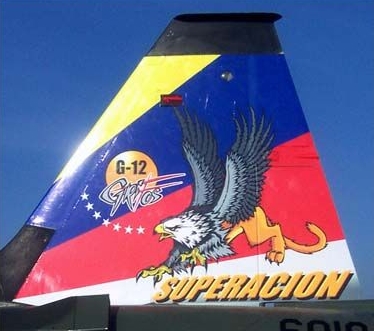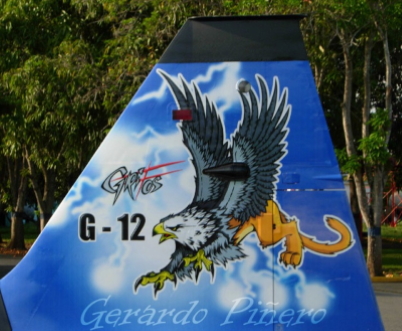 Credit:
Roundels of the world
Credit:
Roundels of the worldRoundel Last update 21-06-2022
 Credit:
Roundels of the world
Credit:
Roundels of the world
Roundel
Last update 21-06-2022
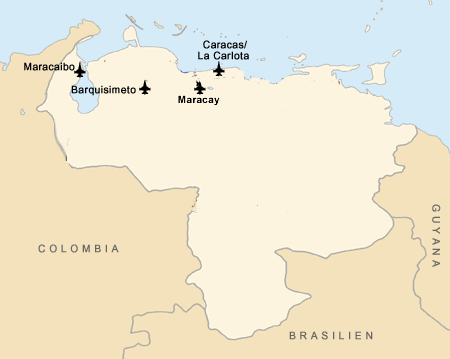 GRUPO AEREO DE CAZA No. 12 "Superacion"
GRUPO AEREO DE CAZA No. 12 "Superacion"
BA "Ten. Vincente Landaeta"/El
Liberator AB - Barquisimento
Escuadron Aereo de Caza 35 "Panteras"
Escuadron de Caza 36
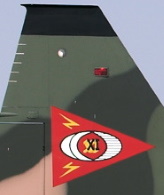
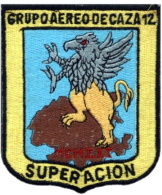
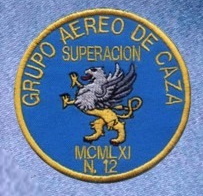
Unit badge on aircraft's tail Variant of badge Variant of badge (which is the oldest one?)
An
offer was made at the beginning of 1965 by Hawker Siddeley Group in
1965 for 15 Hawker Hunters at a cost of USD 13.5 millions but not
accepted. On 23-05-64 the embassy of Venezuela in USA asked details
about the Northop aircraft; on 05-11-64 the
Venezuelan AF Commander in Chief visited Northrop and requested a price
proposal for 12 Northrop F-5A and 3 F-5B. On 11-12-64 Northrop answered
that the Govern-
ment provided for the release of production allocation
and were unable to state the availability of these aircrafts. Costs
were estimated at a flyaway cost of ca. USD 11.00m, increased to ca
US14.5m to include spares
and ground equipment.
At the end of the 1960's a new interceptor was sought; the Saab
35 Draken, BAC Lightning, Dassautl Mirage
III, Canadair CF-5 y el McDonnell F-4 Phantom II. were considered. This last was selected and a request for
32 Phantoms were sent to the USA but this countntry refused delivery stating that all Phantoms were needed for the Vietnam war.
As a second choice the Canadair
CF-5was chosen as the Canadians immediate delivery was possible. The
Ministry de Defensa sent a "letter of intent" to buy 16
Canadair CF-5A (two with reconnaissance nose) and
CF-5D at the cost
of USD 35 millions inlusive equiment and spare parts under the name "Project Canamido". Firm contract was
signed on 14-12-71 after which they were removed from storage at Trenton AB and
Mountainview AB and readied for delivery under the program "Canamigo".
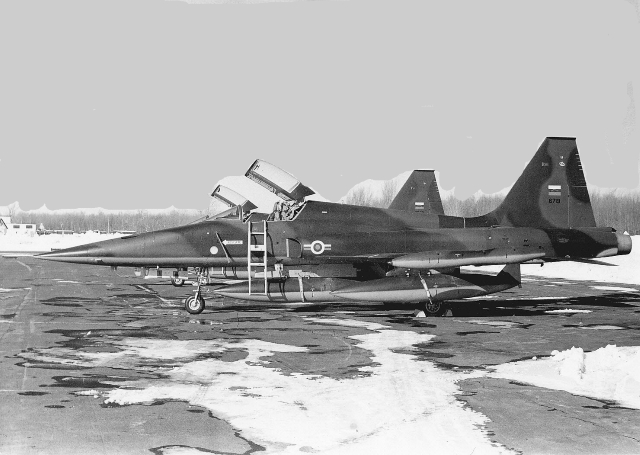 An image rarely seen, Canadair CF-5 6719 amids snow in Canada!
An image rarely seen, Canadair CF-5 6719 amids snow in Canada!
The Venezuelan AF sent pilots and ground personnell to Cold Lake AB, base of the 434 Squadron,
for training where they followed a course. Additionally, 30
maintenace personnell went to the Aircaft Maintenance
Development
Unit at Trenton AB. One Lockheed C-130 departed Trenton on 10-01-72
carrying accessories and spare parts to Venezuela.
Initial 2 Canadair CF-5A and 2 CF-5D were officially handed-over to
Venezuela at Trenton AB where they started their delivery flight in Venezuelan markings on 11-02-72, routing via Myrtle Beach, Homestead AFB,
NAS
Roosevelt (Puero Rico) where they remained overnight to fly next day to
BA El Libertador. Canadian pilots were in charge of the delivery due to inexperience on the aircraft by
their Venezuelan colleagues. Delivery
of the next eight (nine according some sources) CF-5 started in
Trenton on April 12th, 1972 arriving two days later in Venezuela; the
final group left on 07-06-72 arriving 11-06-72.
Their air-refuelling system had been removed in Canada before departure. They obtained a nick-name: "Zancudo". Official transfer of the first ones to the Air Force was on 17-02-72.
The aircrafts replaced North American F-86K - Grupo de Caza 35 and the Grupo de Caza 36 North American F-86F based at Base Aerea General Rafael Urdaneta (Maracaibo); official re-equipment ceremony took place
on 17-02-72. On
05-07-72 12 Canadair CF-A/CF-5D, plus 2 reserve, participated
to the national military parade, though the pilots had not yet
completed their transition to the aircraft.
A Canadian air mission (two persons) helped training on the
new aircrafts, completed inl July 1972. All of them received Canadian serials but never saw
service with this Air Force; two new Canadair CF-5D were
addi-
tionally bought on 27-01-74, arriving on July 1974; during this month the Grupo de Caza 12 was transferred to the Base Aerea "Teniente Vincente Landaeta"/El
Liberator AB in Barquisimento.
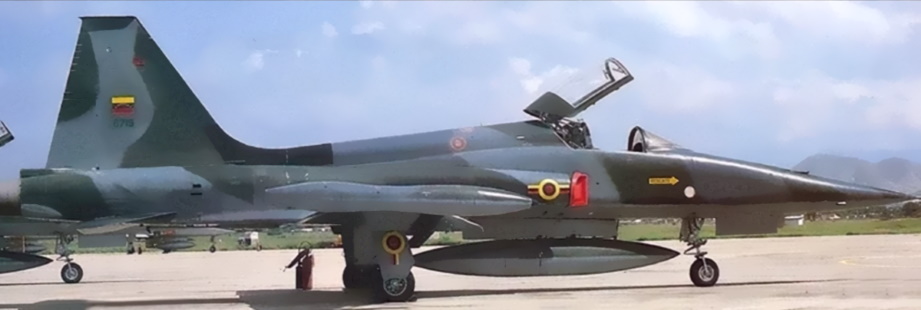 Photo: unknown
Photo: unknown
Canadair CF-5 serial 6719 seen in
its original version.
A contest took place between Northrop and Canadair as this last was not authorised for re-sale of licence-built aircrafts. Northrop sued in 1974 and, finally, Canadair paid USD 9 millions to settle matter.
In
1979 a first upgrade took place to the navigation and communications
equipment, some receiving air photography capability, operation of which started on 25-02-81; the
designation
was changed to VF-5A and
VF-5D (Venezuela instead of Canada).
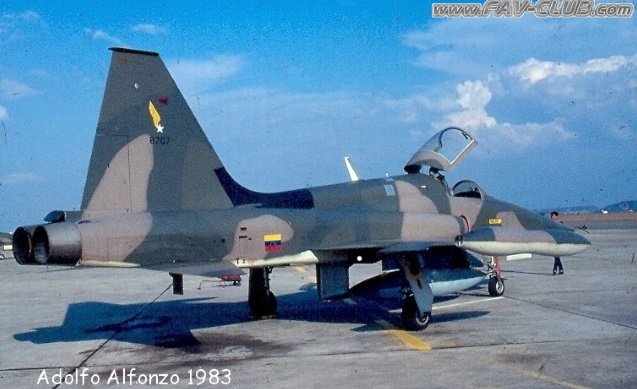
Canadair CF-5A with early tail markings, changed in 1982-1983
The
Escuadron de Caza 35 was re-named on 26-05-86 as Escuadron de Escuela
de
Combate No 35 with 12 Rockwell T-2s (formerly used by Grupo de
Entrenamiento Aéreo de la Escuela de Aviacion Militar) and two
Canaidair VF-5D were assigned to it, reflecting
the training duties of the Squadron. The first six pilots trained by
the Grupo were promoted in November 1987. The single-seaters were
assigned to the Escuadron de
Caza 36.
By
1990 seven Canadairs had been lost; the remaing (approximately ten single and one double-seater) had airframe fatigue problems
and there were budgetary problems. All this contributed to the fact that the
fleet was retired
and aircrafts put in storage.
Friction between Venezuela and Colombia had almost lead to war in August 1987; this prompted a decision for a second refurbishment called operation "Grifo"; it included modification/addition of navigation/commu-
nication systems, flares, an air refuelling system for all aircrafts. The programm started in
June 1990 in collaboration with Singapore Aerospace at a cost of USD 30 millions. One Canadair VF-5A (9124) and 1 VF-5B
(5681) were
sent by ship to Singapore on 09 March 1991 to
be upgrated with HUD, GPS, Litton INS; initially 8 single- and
1 double-seat aircrafts were foreseen in the contract. Air-to-air refuelling was reinstated in
order to be refuelled by one B.707-320C bought, capability in the meantime lost when these aircrafts withdrawn from use around 2'000.
Engines were sent to the orinal manufacturer Orenda for overhauling. Air-to-air missiles AIM-9B were replaced by more modern AIM-9P3.
Some action to increase the fleet was additionally taken: six Canadair NF-5B and 1
Canadair NF-5A were bought from the Netherlands in 1991, air
delivered by Lockheed C-130 between May 1992 and January 1993;
they
were assembled at the DIPROA maintenace hangar in BA El libertador
(Maracay). Tests in the Netherlands were done without wearing a serial.
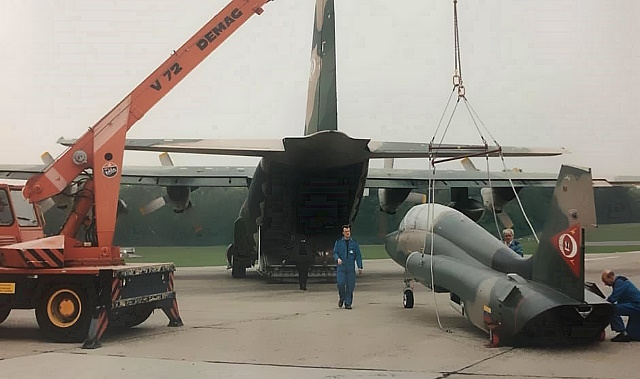
Canaidair NF-5A prepared to be loaded at Woendsrecht into a Venezuelan C-130
During
the 07-11-92 revolution they had no relevant operation as they were
dispersed and
not operational awaiting modernisation but 3 still were destroyed
at Barquisimeto AB (awaiting modifictation to Grifo standard)
by North American OV-10 Broncos.
The pattern VF-5A an VF-5D were returned from Singapore by Lockheed C-130H in May 1993; now re-named VF-5Au or VF-5Bup (not confirmed), locally re-assembled under the supervision of Singaporean specialists,
underwent further testing; the programm was to enable their operation till ca. 2015.
Modification in Venezuela was started on 07-09-93 with Grupo 12 (80%) and
Singaporean (20%) personnell. The first double-seater upgraded directly
by the Grupo was delivered to the Air Force in October. Later, in a
second contract (signed 1993), going on till 1996 1 Canadair VF-5D and 6 VF-5A were modified in Venezuela. Initial works were performed at BA
Maracay/ El Libertador by the Servicio de Mantenimento de l'Aviacion,
substituted by the Escuadron de Mantenimento 127 based at BA
Barquesimento. Additional
modification was to enable to carrying AIM9-P3 SIdewinder, instead of
the earlier AIM-9B; some 35 engines were revised by the
Canadian
company Orenda. A
total of 8 single and 1 double aircrafts were modified, total cost being USD 60 millions.
The advanced trainers North American T-2D were withdrawn from use in the year 1999 leaving this role to the Northrop VF-5Bs.
A
second uprade followed in 2002 at Barquisimeto AB (utilising parts of circa 12 remaining airframes) for the two-seaters in best
conditions (1 Canadair CF-5 and 2 Canadair NF-5B) with the help of Elbit Systems; works
for structural
reinforcement, general overhaul and avionics started at Barquisimeto AB
in 2003.
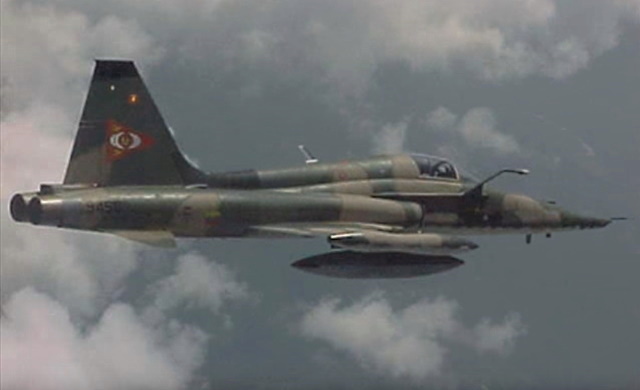 Photos: unknown
Photos: unknown 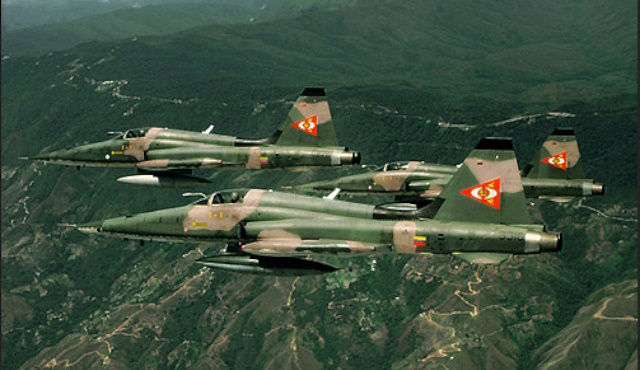
Updated Canadair VF-5Au serilal 9456
(of 2) with
reconnaissance nose, end of
1990s
Canadair VF-5Au serilal 3310 with reconnaissance nose, with 2 standard nose Canadair VF-5Au
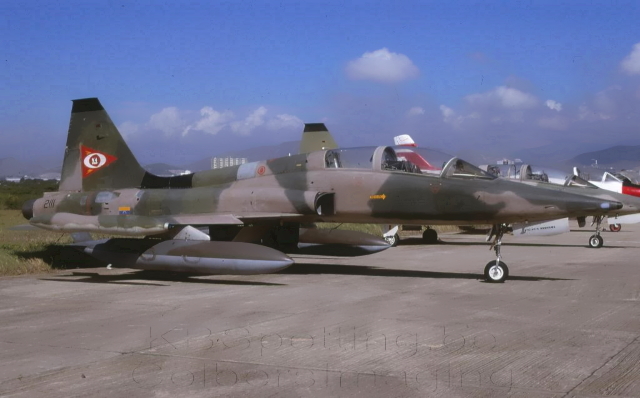
Northrop NF-5B 2111 stored at Barquisimeto on December 2000.
Very
much a surprise was the announcement in February 2007 that Iran
would maintain and modernize 12 Canadair VF-5A and VF-5B for USD 70 millions;
an Iranian commission visited Venezuela, further details
are not known. Anyhow, there was no knowed follow-up.
All remaining, upgraded aircrafts (8 Canadair VF-5A, 3 VF-5B,
1 VF-5D) were mainly
being used for pilots training of future General Dynamics F-16A and
GAD Mirage III/5, remaining based in 2000 at Barquisimeto AB
with Grupo 12.
By February 2002 the operation of Canadair VF-5A/VF-5B/D was reduced to ten operational airframes because of maintenance problems.
The United States of America posed an embargo on all arms delivery in 2005 due to the left oriented politics of the Venezuelan Government which inpacted delivery of spare parts; by the end of 2010
the last three
ended flying mainly due to a shortage of spare parts (without any official mention), also resulting in the cannibalisation and withdrawal of several aircrafts types. They were stored at Barquisimeto AB.
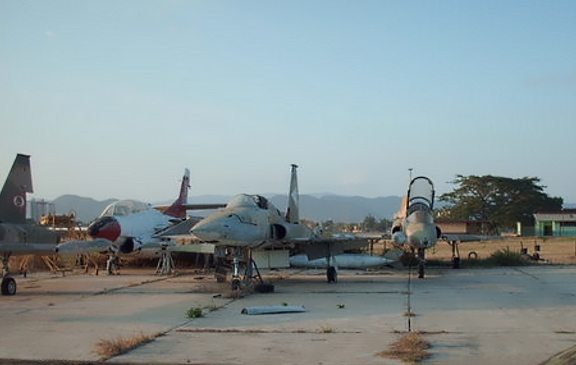 Photo: Manuel Ernesto Silva
Photo: Manuel Ernesto Silva
Two Canadair CF-5As single- and one CF-5 double-seaters at Barquisimeto AB withdrawn from use on 01-07-05.
Reflecting the political situation a change of designation to Fuerza Aere Bolivariana was established by Presidential Decree on 10-12-09.
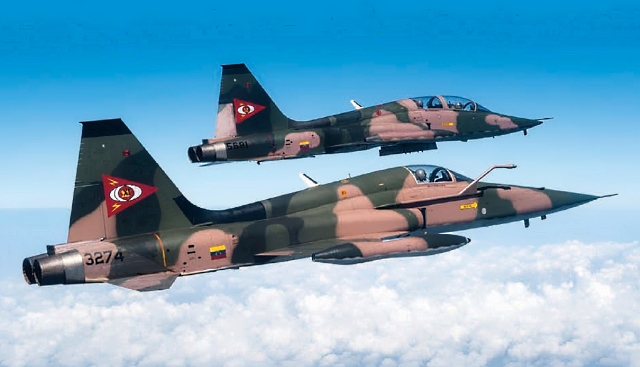 Photo: Sergio J Padron A
Photo: Sergio J Padron A
In-flight photo on 04-06-10 of Canadair CF-5A 3274 and CF-5 5681 after
modification.
At the end of 2010 there were 2 Northrop NF-5A/B (of 7 delivered) and 4 Canadair/Northrop VF-5A and VFR-5A (of 16 received) operational.
Last aircrafts to fly were 3 two-seaters at the end of 2010. A replacement solution was found when the first lot of 6 Hongdu K-8W (out of 18) armed intermediate trainers replaced the Canadairs (this time equipping
the 12o Grupo Aereo de Caza and the 15o Grupo de Operaciones Especiales): first official delivery of the Chinese trainer was on 13-03-10, delivery completed by September 2010.
One silver Canadair NF-5A is preserved at the
Barquisimeto gate, a camouflaged one is preserved in
Barquisimeto town but was damaged/destroyed by vandals, another camouflaged
one is at the Museo Nacional de
Aeronautica in Maracay since at least
October 2014.
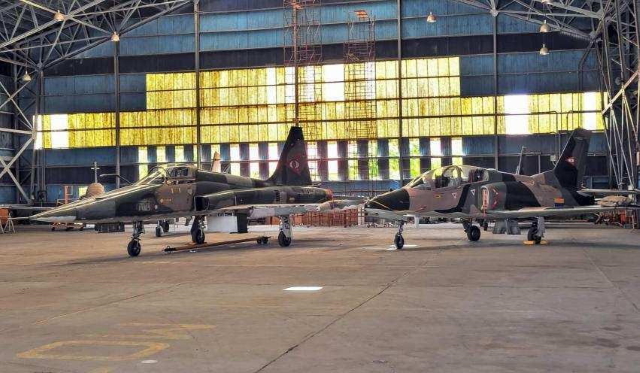 Photo: unknown
Photo: unknown
Museum VF-5A aircraft with its
successor
- CATIC K-8
EXCERCISES
On 25-02-81 Freedom Fighters operated as Target Tug in favour of Mirage III and 5, CF-5 from Grupo 12 and (starting from 1985) General Dynamics F-16A from Grupo No 16.
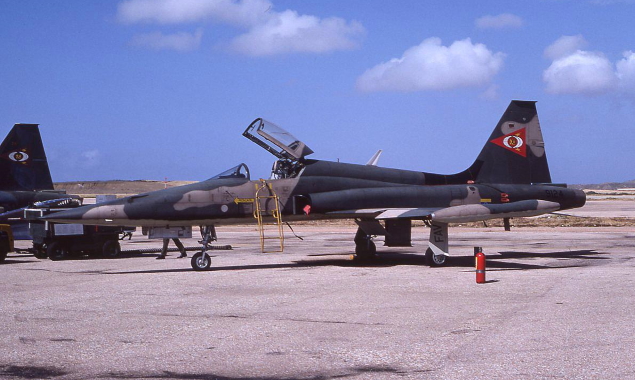
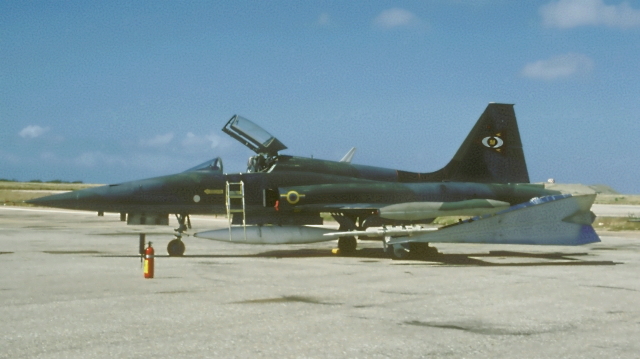
Canadair CF-5A serial 9124 seen at Margarita Island airport during April 1990 Canadair CF-5V 3318 at the same date/airport used as Target Tug
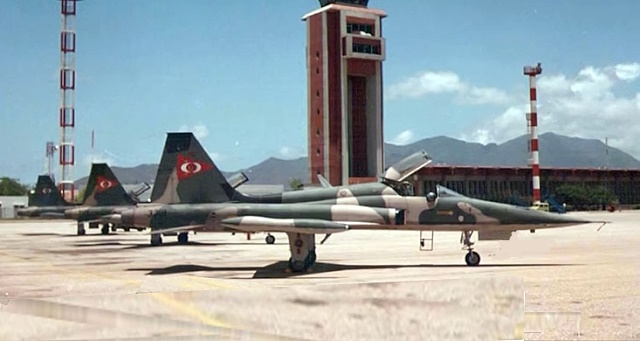
Line-up of 3 Canadair
CF-5A at Margarita Island airport during April 1990
"Operacion Dardo" began at the beginning of the 1980 after a delegation had
come back from Canada as an yearly exercise at the BA Luisa Caceres de Arismende, forty
miles from the Margarita Island. It cosisted of live
air-to-air
shooting to a target flown by Canadair CF-5s
against same aircrafts, later against
GAMD Mirage III/50s and General Dynamics F-16s. Canadair CF-5A 4005
seen above is shown as a Target Tug with the target
A/A37U-15 External
Tow Target System. The exercise was shown to high officers for the first time on 25-02-81.
Collaboration
with the USAF was initiated in 1987 with an exchange programm with the
Puerto Rico Air National Guard flying LTV A-7D with air-to-air exercises with Canadairs, among which shooting against air-targets.
"Exercise Miranda I-98" French-Venezuelan exercise took place between 08th and 12th Februar 1998. The Canadair
CF-5s belonging to the Grupo Aereo No.12 participated together with
General Dynamics F-16A/F-16B of
the GAe No16 and the Mirage 50EV of the GAe No11 together with 4 French Mirage 2000D (EC2/3), 1 Boeing KC-135F and 1 Lockheed C-130H. The exercise was held at the El Libertador AB against targets at the polygon
situated on the La Orrchila Island . The Canadairs used "dumb" bombs
Operation
"Cruzex 2006" held out of Anàpolis AB (Brasilia) was ther name of an international exercise where the
Venezuelan took part from the 21-08-06 till 01-09-06, sending 3
2 Canadair VF-5A, 3 GAMD Mirage 50EV/DV,
3 General Dynamics F-16A/B. Argentina,
Chile, Peru, Uruguay, France were additional participants. They operated in the in the ground attack, COIN and CSAR roles.
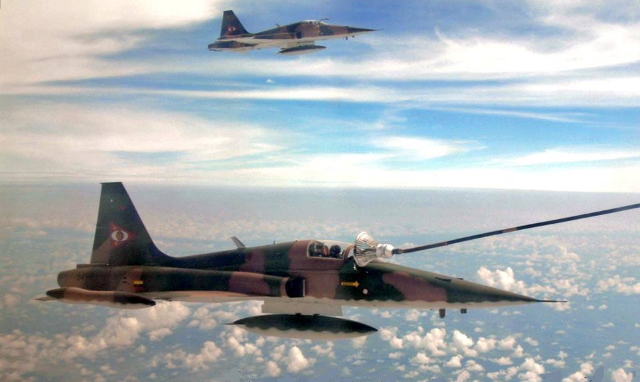 Photo: Via FAV-Club
Photo: Via FAV-Club
Air-to-air refuelling next to Natal (Brazil) of an unknown, upgraded
Canadair CF-5A
One year later, in March 2007, one Canadair VF-5A and 1 VF-5D represented Grupo 12 at the excercise "Operacion Resistencia 01-07". Trained were day and night operations from an emergency road air base
(la Marquesena).
A further exercise took place between the 31-05 and 10-06-10, called "Operacion Paraguana 2-2010 ".
Three Canadair VF-5 and six CATIC K-8W operated from BA Tactica
Fernandez Boliva (Peninsula Paraguana) to
train pilots in basic fighter
manoevers and formation of instructors on the new Chinese trainer.
Colours
The
single-seaters retained their original colours: single-seaters
delivered in Canadian camouflage, the double-seaters in metallic
colours, later both changed to South East Asia colours in XXX?.
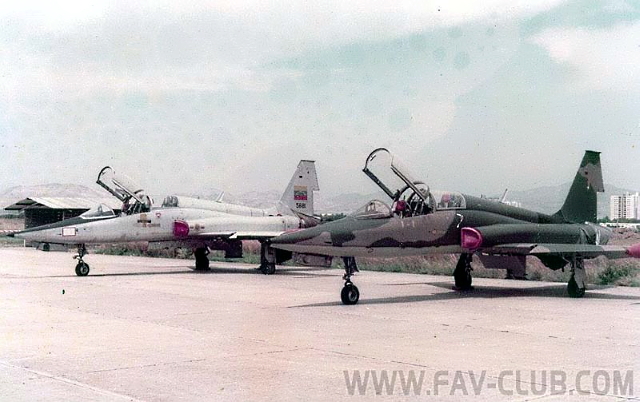 Metallic aircraft is serial 5681
Metallic aircraft is serial 5681
Original plans were to realize three special painted tails on operational aircrafts;
this is not confirmed it did ever happened.
